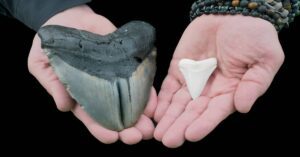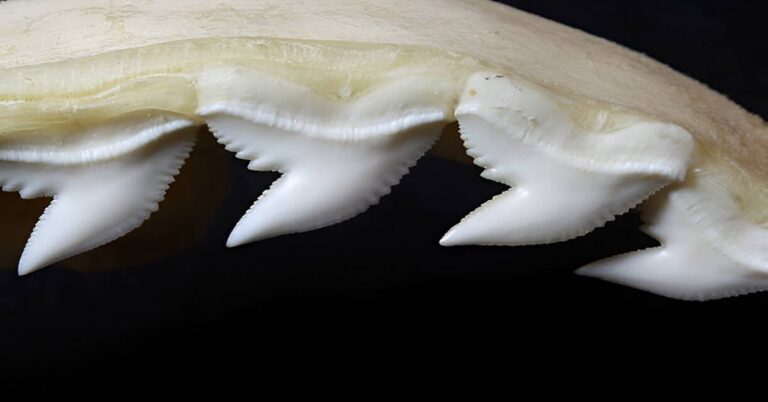When I first heard the term lemon shark tooth, I was fascinated. To be honest, I imagined these sharks might somehow resemble the fruit – maybe a bit yellow and sweet-looking. But as I dug deeper, I learned that their name comes from the yellow-brown hue that helps them blend into the sandy coastal habitats they prefer. I’ve always loved sharks, and the lemon shark is one of the most interesting species, especially when you take a close look at their teeth.
Lemon shark teeth are unlike anything I’ve seen in the ocean, and they play such a crucial role in how these sharks hunt and thrive. In this article, I’m going to share what I’ve learned about the anatomy of lemon shark teeth, how they’re identified, and why they matter so much for both the sharks and us.
What is a Lemon Shark Tooth?
If you’ve ever wondered what makes a lemon shark tooth stand out, you’re in the right place. A lemon shark tooth is easily recognizable due to its triangular shape with smooth, narrow edges. Unlike the jagged, serrated teeth you might see in a Great White Shark, lemon shark teeth are built for gripping and holding onto fish or crustaceans rather than tearing through tough meat. Their design is more about precision and control.
I had a friend who was an avid diver, and during one of his trips to the Bahamas, he found a lemon shark tooth lodged in the sand. He described it as both sharp and surprisingly delicate, with the perfect symmetry you’d expect from something so perfectly adapted for its purpose. These teeth are not just tools—they are a signature of the shark’s evolutionary success.
The teeth themselves grow in rows and are constantly replaced. This is common among sharks, who shed thousands of teeth throughout their lifetime. It’s a bit like getting a new set of teeth every few years—always fresh, always sharp.
The Anatomy of a Lemon Shark’s Teeth
Lemon sharks have a pretty unique dental structure that serves them well in their environment. The teeth are narrow and have triangular, smooth-edged cusps that help the shark grip onto its prey. The upper teeth tend to be broader at the base and sharper near the tips, while the lower teeth are more uniformly shaped and pointy, giving the lemon shark a uniform advantage when catching and eating prey.
I remember watching a documentary once where the narrator explained how the lemon shark uses its teeth to capture prey like rays, fish, and even cephalopods. I couldn’t help but imagine how their teeth work in tandem with their speed and agility—kind of like a tool that’s made perfectly for its job.
What’s even more fascinating is how these teeth help the shark adapt to different environments. The teeth are designed for coastal foraging—they’re excellent for catching smaller prey near the sandy seabeds and rocky shorelines. It’s almost like they were built for their home—the shallow waters where they live and hunt.

Lemon Shark Teeth vs. Other Shark Teeth
When we think about sharks, we often picture those terrifying, sharp, serrated teeth. But lemon sharks are different. Their teeth are surprisingly smooth, which helps them grip and hold prey without tearing it apart. This is a notable difference compared to sharks like the Great White or Tiger Shark, whose teeth are built for cutting through thick, tough flesh and bone. Lemon sharks, on the other hand, target fish, rays, and even smaller sharks, so they don’t need teeth that rip and tear—they need teeth that can latch onto and hold.
It’s like comparing a hunting knife (Great White) to a precision tool (lemon shark). While the former is built for cutting, the latter is designed for a different kind of efficiency.
Lemon shark teeth are adapted to their diet. While the Great White might use its teeth to tear apart seals, the lemon shark’s teeth help it secure fish and other soft-bodied prey. It’s a perfect example of how animals evolve to fit into their environment.
Why Lemon Shark Teeth are Important in Shark Identification
One of the most fascinating things about lemon shark teeth is how they help identify the species. When paleontologists study ancient shark fossils, they rely on the structure of teeth to figure out which species the fossil might belong to. The unique smooth-edged structure of the lemon shark’s teeth makes it relatively easy to identify in fossil records. This is a crucial factor in studying shark evolution.
When I was reading through shark research articles, I realized that many times, researchers will use fossilized teeth to trace the history of these fascinating creatures. In some cases, scientists have used the teeth of ancient sharks to learn about how they evolved and adapted to changing oceanic environments over millions of years.
In modern times, shark teeth are also used to identify species while diving. If you’ve ever dived into the deep blue and come across a shark’s tooth, knowing the specific shape can tell you a lot about the species you’re dealing with. I’ve heard people say that recognizing the lemon shark tooth, with its characteristic triangular and smooth shape, makes it easier to identify the shark from a distance.
Lemon Shark Teeth: A Fascinating Component of Nature
In this first section, we’ve explored what makes lemon shark teeth unique and how they contribute to the shark’s survival. Their distinct anatomy, their role in the shark’s feeding habits, and their importance in identifying the species make them one of the most interesting features of the lemon shark. Whether you’re a diver, a paleontologist, or just an ocean enthusiast, understanding lemon shark teeth gives you a deeper appreciation of how this incredible species operates in the wild.
Next, we’ll dive deeper into some fun facts about lemon shark teeth, and I’ll share more about how these fascinating creatures use their teeth in the wild to survive. Stay tuned!
Key Features of Lemon Shark Teeth
| Feature | Description |
| Shape | Triangular, smooth-edged teeth with narrow cusps. |
| Size | Teeth are typically around 0.75 inches long. |
| Structure | Upper teeth are broader at the base, while lower teeth are uniformly pointed. |
| Function | Designed to grip prey like rays, fish, and small sharks without tearing. |
Lemon Shark Teeth vs Other Shark Teeth
| Shark Type | Teeth Structure | Function |
| Lemon Shark | Triangular, smooth-edged, narrow cusps | Gripping and holding prey |
| Great White Shark | Large, serrated, broad triangular teeth | Tearing and cutting through tough flesh |
| Tiger Shark | Serrated, long, curved teeth | Cutting through prey, including sea turtles |
Fun Facts About Lemon Shark Teeth
Lemon sharks may not seem as terrifying as the great white or the tiger shark, but their teeth are incredibly efficient for their lifestyle. I remember the first time I learned about their teeth – I was amazed by how perfectly adapted they were to their needs. These sharks spend most of their time in shallow coastal waters, hunting fish and crustaceans. The smooth-edged, triangular teeth make it easy for them to grab their prey, hold on, and swallow it. It’s not about ripping through flesh like you might imagine with other sharks, it’s about precision and control.
It wasn’t until I watched a few underwater documentaries that I truly understood how lemon sharks use their teeth. They swim close to the seabed, often blending into the sand, and wait for a school of fish or a ray to pass by. Their teeth are designed to hold onto their catch without much effort. The teeth are also replaced constantly, ensuring that the shark always has a fresh set of tools for hunting. I couldn’t help but feel a bit in awe of how nature always finds a way to equip animals with exactly what they need to survive.
These facts about lemon shark teeth make me appreciate the fine balance of the natural world. The design of each shark’s teeth, including the lemon shark, is so intentional and has been fine-tuned through millions of years of evolution. Their teeth are a tool—efficient, effective, and perfectly suited to their needs.
The Lemon Shark’s Feeding Habits and Its Teeth
I once went diving in the Bahamas and had the incredible experience of seeing lemon sharks in action. Watching them glide through the water, using their teeth to catch fish, made me truly realize how important their teeth are. Lemon sharks are predatory creatures, but unlike some sharks that rip their food apart, they are more about catching and holding. Their diet consists mainly of bony fish, rays, cephalopods, and sometimes smaller sharks. Their teeth serve as the ideal tool for grabbing hold of these fast-moving creatures.
One thing that really struck me was how lemon sharks seem to almost “plan” their movements before going in for the catch. They use their teeth to latch onto their prey without causing much disruption, quietly returning to the ocean floor to feast. It’s a different kind of hunting—stealthy, precise, and efficient.
Their smooth-edged teeth don’t rip apart prey but allow them to secure their catch. If you’ve ever watched a video of a lemon shark hunting, you’ll see that its teeth play an essential role in helping the shark hold onto its meal long enough to enjoy a successful hunt. When I learned this, I started thinking about how our tools and techniques for getting things done work the same way—precision and efficiency are key.
Lemon Shark Diet
| Prey | Teeth Function |
| Bony fish | Teeth grip and hold onto the slippery fish. |
| Rays | Teeth latch onto soft-bodied prey. |
| Cephalopods | Teeth are used for gripping fast-moving creatures. |
| Smaller sharks | Teeth hold and capture smaller, agile prey. |
The Role of Teeth in Lemon Shark Behavior and Ecology
Lemon sharks are often misunderstood when it comes to their behavior. Many people picture sharks as solitary hunters, but lemon sharks are quite social. They often form groups or schools, especially during their juvenile years. These groups help protect the sharks from larger predators. I had no idea that sharks, like lemon sharks, could be so social. I thought they all just roamed around in isolation, but in reality, group hunting and social interaction are vital parts of their survival strategy.
As lemon sharks grow, they begin to develop their own territories, but they still tend to congregate in certain spots. I think it’s a lot like how humans work in some ways—there’s a sense of comfort in being with others of your kind. Their teeth, however, are always their first line of defense and offense. They use them not only to hunt but to defend themselves from threats. If a larger shark comes along, the lemon shark’s teeth are ready to secure a safe escape.
Lemon sharks, despite being formidable predators, are also part of a delicate ecological balance. They help control the populations of smaller fish and maintain the health of the marine ecosystem. Their social behavior, combined with their specialized teeth, makes them a unique player in the ocean’s food chain.
When I think about it, the lemon shark’s teeth are more than just tools for eating—they are key to their survival in a competitive world. Their role in the food chain highlights the importance of every creature, no matter how small or seemingly insignificant.
Lemon Shark Teeth in Fossils
Fossilized lemon shark teeth are incredibly valuable to researchers. I remember reading about how scientists study shark fossils to understand ancient species and their evolutionary paths. Teeth are often the only remnants that last over millions of years, so they are the primary tool used to trace the lineage of sharks. Fossilized lemon shark teeth, found in various parts of the world, provide key insights into how these creatures evolved to adapt to their habitats.
The most remarkable thing about studying these ancient teeth is seeing how much they have stayed the same, despite the vast changes in the ocean’s ecosystems. By examining the teeth, scientists can learn about past climates, ocean conditions, and even the prey that sharks fed on during earlier periods of history. Lemon shark teeth, while small and seemingly unremarkable, have unlocked a treasure trove of information about our planet’s past.
Every time I look at a fossilized shark tooth, I can’t help but think about the centuries that have passed, and how these teeth have stood the test of time. The shape and structure of the lemon shark tooth have remained fairly consistent over millions of years, making it an important piece of the puzzle in understanding shark evolution. Studying these fossils gives us a glimpse into the world that existed long before humans walked the earth.
In this section, we’ve delved into the fascinating facts about lemon shark teeth, their role in the shark’s diet, and how these teeth connect to the behavior and social structure of lemon sharks. It’s pretty remarkable how something as simple as a shark’s tooth can offer us so much insight into the life and survival of these incredible creatures. Stay tuned, as we move into the next part of this journey where we’ll explore the conservation challenges facing lemon sharks today.
The Conservation Status of Lemon Sharks
If you’ve ever watched a lemon shark glide through the water, you’ll know just how majestic they are. But behind their beauty, these sharks face significant challenges. As apex predators in their environment, lemon sharks play an essential role in maintaining the balance of the ecosystem. Unfortunately, their populations are now considered Near Threatened by the IUCN Red List, meaning that they are at risk of becoming endangered if conservation measures aren’t put in place.
Lemon sharks are vulnerable for a few reasons, but one of the main factors is overfishing. Their slow reproductive cycle makes them particularly susceptible. Unlike some other species of sharks that mature quickly and have multiple offspring each year, lemon sharks don’t reach sexual maturity until they’re around 12 to 13 years old, and they only produce 4 to 17 pups per litter. It’s like trying to keep a garden healthy with just a few plants growing at a very slow rate—if you lose even one of those plants, it takes a long time to recover.
I remember speaking to a marine biologist who emphasized that fishing practices—both commercial and recreational—are the primary threat to lemon sharks. They are often caught accidentally as bycatch in fishing nets, which has a devastating effect on their population. On top of that, the demand for shark fins, including those of lemon sharks, contributes to their declining numbers.
Lemon sharks, like many other marine species, are also affected by the degradation of their habitats, such as mangroves and coral reefs. These areas serve as nursery grounds for young sharks, offering them a safe place to grow and develop. However due to coastal development, pollution, and climate change, these critical habitats are disappearing. This makes it even harder for lemon sharks to survive and reproduce, creating a vicious cycle that affects the entire ecosystem.
The good news is that conservation efforts are underway. Researchers, environmental organizations, and government bodies are all working together to protect lemon sharks and their habitats. Some regions have implemented fishing quotas, and shark sanctuaries have been established to safeguard these predators. These measures are crucial in ensuring that lemon sharks, along with their iconic teeth, remain part of our oceans for generations to come.
Conservation Threats to Lemon Sharks
| Threat | Impact on Lemon Sharks |
| Overfishing | Decreases population due to capture as bycatch and targeted fishing. |
| Slow reproductive cycle | Limits recovery rates, as lemon sharks take longer to mature. |
| Habitat destruction | Loss of critical nursery habitats in mangroves and coral reefs. |
Threats to Lemon Shark Teeth and Population
I always find it fascinating how something as small as a lemon shark tooth can play a role in the survival of an entire species. The teeth of lemon sharks are an integral part of their hunting strategy, but ironically, they can also be a reason why these sharks are at risk. In many parts of the world, sharks are still targeted for their fins, teeth, and skin. For lemon sharks, this means their teeth are highly sought after.
The demand for shark teeth—whether for souvenirs, jewelry, or even as a form of trophy—has been a major concern. I remember hearing a story from a diver friend who visited a coastal village where people were selling shark teeth, including those of lemon sharks. It made me think about the way we often overlook the impact of these small trade practices. These teeth, while fascinating and beautiful, are part of the reason why sharks like the lemon shark are in danger.
It’s not just the physical act of harvesting shark teeth that poses a problem, but the broader effects of shark finning and the black market trade. The connection between lemon shark teeth and the sharks’ overall survival is undeniable. When sharks are killed for their teeth and fins, the removal of these apex predators disrupts the delicate balance of the oceanic food chain.
Another reason for concern is the effect of pollution on the habitats where lemon sharks live. I’ve read reports about how toxic chemicals in the ocean can affect the health of sharks, including their teeth. Pollution weakens the immune systems of marine creatures, making them more susceptible to diseases. This can lead to damage to their teeth, further impacting their ability to hunt and survive.
But the biggest threat to lemon sharks and their teeth is the continued destruction of coral reefs and mangrove forests. Without these vital ecosystems, juvenile lemon sharks have fewer places to grow and mature, and the entire lifecycle of the species is at risk. The loss of these habitats reduces the chances of lemon sharks reproducing, which means fewer sharks, fewer teeth, and a growing decline in their population.
Protecting Lemon Sharks and Their Teeth: What You Can Do
If you’ve ever felt a sense of wonder when encountering a lemon shark, you’re not alone. I think everyone who’s had the chance to see one of these magnificent creatures understands how important it is to protect them. The good news is that there are things we can all do to help.
One of the simplest ways to protect lemon sharks is by supporting conservation organizations that are working to create safe environments for sharks. These organizations help establish marine protected areas (MPAs), which offer sanctuary to species like lemon sharks. You can also get involved by advocating for stronger environmental protections that regulate fishing practices and reduce bycatch.
Another way we can help is by being more mindful of the products we purchase. When I learned about the trade of shark teeth and fins, I realized how small actions could make a big difference. Boycotting products made from shark parts and spreading awareness about the dangers of shark finning are crucial steps in reducing demand. Additionally, supporting sustainable seafood initiatives can ensure that sharks, including lemon sharks, are not unintentionally harmed during commercial fishing.
Lastly, educating others about the importance of sharks in the ocean ecosystem is one of the most powerful tools we have. I’ve had countless conversations with friends about how sharks contribute to a healthy marine environment, and it’s incredible to see how one person’s awareness can spread to many others. The more people know about the beauty of lemon sharks and their essential role in maintaining ocean balance, the more likely they are to support their conservation.
FAQ
How long do lemon sharks live?
Lemon sharks can live up to 27 years in the wild. Their slow maturation and long lifespan make their population recovery a lengthy process.
Where are lemon sharks commonly found?
Lemon sharks are typically found in shallow coastal waters of tropical and subtropical regions. They are common in the Atlantic Ocean, including the Gulf of Mexico, and parts of the Pacific Ocean.
Do lemon sharks live alone or in groups?
Lemon sharks are social creatures. They often form groups or schools, especially during their juvenile years, for protection and interaction.
What do lemon sharks eat?
Lemon sharks mainly feed on bony fish, crustaceans, rays, and sometimes even smaller sharks. Their teeth are well adapted for gripping prey rather than tearing it apart.
How many teeth do lemon sharks have?
Lemon sharks have multiple rows of teeth in each jaw, with up to 50 teeth per row. Their teeth are continually replaced throughout their lives.
Why are lemon sharks important to the ocean ecosystem?
Lemon sharks are apex predators, helping to maintain the balance in marine ecosystems by controlling populations of smaller fish and prey species.
Are lemon sharks aggressive?
Lemon sharks are not typically aggressive towards humans. They are generally peaceful but should be approached cautiously, like all wild animals, in their natural habitat.
What makes lemon shark teeth unique?
Lemon shark teeth are smooth-edged and triangular, perfect for gripping prey. They differ from the serrated teeth of other sharks, which are used for tearing flesh.
Conclusion
Lemon sharks are one of the most fascinating creatures of the ocean, and their unique teeth play an essential role in their survival. Their ability to thrive in shallow coastal waters, combined with their social behavior, makes them one of the more interesting shark species to study and admire. With their smooth-edged, triangular teeth, they are adept at gripping prey, and this specialized feature allows them to feed efficiently on fish and rays without the need for tearing through tougher animals like other sharks. It’s a testament to the power of evolution and how every aspect of a creature’s body is fine-tuned to its environment.
Despite their relatively peaceful nature, lemon sharks are facing serious threats. Overfishing, habitat destruction, and the illegal shark fin trade are driving these incredible animals toward a vulnerable status. With slower reproduction rates and limited natural predators, their ability to bounce back from population declines is slow, making conservation efforts crucial.
It’s up to all of us to take action—whether it’s supporting sustainable fishing practices, promoting marine protected areas, or simply spreading awareness. Every step counts in helping to secure a future where lemon sharks and their iconic teeth are a thriving part of our oceans.





